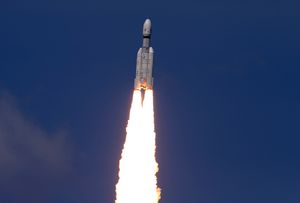As I write these words, Chandrayaan-3 is just 1,400km away from the moon. As you receive this issue of THE WEEK, all systems should be ready for the expected safe landing on the moon on August 23. A major space triumph, accomplished by very few countries, should be ours.
India’s space programme is among the oldest and most ambitious on the planet. We have undertaken missions to the Moon (Chandrayaan-1 and Chandrayaan-2) and Mars (Mars Orbiter Mission), created our own launch vehicles and satellites, and now plan to send an Indian citizen into low earth orbit by 2023.
But what does all this mean for India’s standing on the world stage? There is no doubt that India’s space programme bolsters our national development and global influence and showcases our technological prowess. India has been conducting space activities on a shoestring budget: not only was the successful Mars orbit a rare triumph (no other country had succeeded in a Mars orbit on its first attempt), but it was conducted at 11 per cent the cost of NASA’s programme, and slightly under the budget of the Hollywood space movie Gravity.
As a result India can afford to provide low-cost launch services to other nations, demonstrating our innovativeness and capacity. We have entered a new era of participation and influence in international space cooperation and governance, engaging actively with multilateral forums and bilateral partners. India also nurtures a vibrant private space sector, contributing to the global space economy.
A bright future awaits. India’s space programme is set to skyrocket. Experts predict it could make up at least 10 per cent of the global space economy in the next decade, a significant leap from the current two per cent. According to the Indian Space Research Organisation, India has pursued bilateral and multilateral relations with space agencies and space-related bodies with the aim of strengthening existing ties between countries; taking up new scientific and technological challenges; refining space policies and defining international frameworks for exploitation and utilisation of outer space for peaceful purposes.
Among the foreign countries that have used India’s space programme to launch their own satellites and benefit from space co-operation with India are France, a space partner since 1964, which has supported India’s development of launch vehicles, satellites, applications and human spaceflight, and has also launched several satellites using India’s Polar Satellite Launch Vehicle (PSLV) and Geosynchronous Satellite Launch Vehicle (GSLV); Russia, another long-time collaborator on various aspects of space exploration, including launch vehicles, satellites, planetary missions and training four Indian astronauts plus supplying key components for the crew module of Gaganyaan; and the US, with which India has a strategic partnership in space, covering areas such as earth observation, satellite navigation, space science, planetary exploration, launch services and human spaceflight. The US, Israel, Singapore, Canada, Germany, Indonesia, Japan, Luxembourg, the Netherlands, South Korea, the UK and many more have also launched several of their satellites using India’s PSLV and GSLV.
India has cooperated with many of these countries on various aspects of space technology, such as remote sensing, communication, navigation, telemetry, tracking and command, and propulsion. ISRO is planning to launch missions to study the Sun (Aditya-L1) and Venus (Shukrayaan-1) in the near future.
Driven by the vision of Jawaharlal Nehru, and sustained by brilliant home-ßgrown talents like Dr Vikram Sarabhai, India’s space programme is consumed by various factors such as national development, scientific curiosity, strategic interests and international prestige. Those who once scoffed at a poor country aspiring to send rockets into space now concede that India’s space programme has contributed to various socio-economic benefits such as disaster management, education, health care, agriculture, fisheries, urban planning and more.
A classic photograph from the early 1960s shows Indian rocket parts being transported on a cycle. We have come a long way since then. When Chandrayaan lands on the moon—and though things could still go wrong, as they did with Chandrayaan-2, ISRO chief S. Somanath is confident it will get there—the news will confirm India’s global status as a leader in space exploration. As we look up at the skies, we can contemplate an even more glorious future. New horizons beckon beyond the stars.
editor@theweek.in


